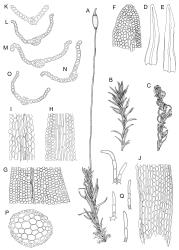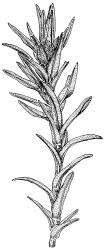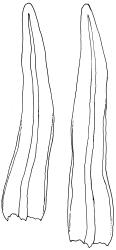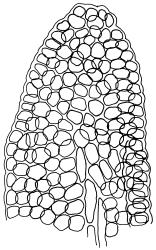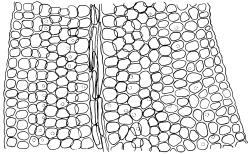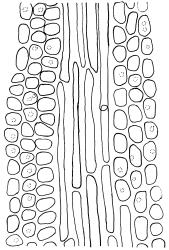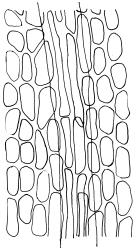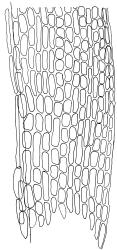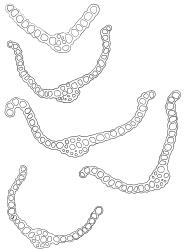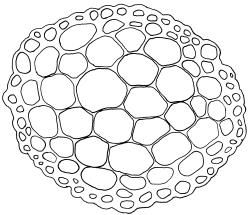- ≡ Trichostomum cockaynei R.Br.bis, Trans. & Proc. New Zealand Inst. 29: 486 (1897) – as cockaynii
- = Weissia weymouthii R.Br.bis, Trans. & Proc. New Zealand Inst. 31: 439 (1899) – as waymouthii
- ≡ Weissia lancifolia var. weymouthii (R.Br.bis) Wijk & Margad., Taxon 9: 52 (1960)
- ≡ Didymodon weymouthii (R.Br.bis) R.H.Zander, Bull. Buffalo Soc. Nat. Sci. 32: 162 (1993) – as Didymodon waymouthii
- ≡ Geheebia weymouthii (R.Br.bis) R.H.Zander, Framew. Post-Phylogenet. Syst. 95 (2013) – as Geheebia waymouthii
- ≡ Tridontium weymouthii (R.Br.bis) J.A.Jiménez & M.J.Cano, J. Syst. Evol. 60: 300 (2021)
- = Weissia weymouthii var. β R.Br.bis, Trans. & Proc. New Zealand Inst. 31: 439 (1899) nom. inval.
- = Dicranum kowaiense R.Br.bis, Trans. & Proc. New Zealand Inst. 35: 330 (1903)
Plants gregarious or in turves, pale yellow-green to dark green-brown. Stems 3–40 mm, simple, or branched by innovation, in cross-section without central strand, with outer cells in several layers thick-walled and with small lumens forming a well-defined sclerodermis. Leaves erect-spreading or rarely recurved when moist, lightly contorted when dry, 1.5–2 mm, ligulate, broadly channelled, rounded and flat or weakly cucullate at apex; margins unbordered, narrowly recurved from near base to mid leaf or occasionally plane, ± entire to crenulate by bulging cells with or without low rounded papillae; upper laminal cells clear in outline, irregularly isodiametric, becoming oblate towards the leaf margins, firm-walled, weakly bulging, obscurely or conspicuously papillose with 1–2 low, rounded, and simple papillae, or occasionally smooth, 9–12 × 6–11 µm, c. 10–15 cells between costa and margin at mid leaf, becoming oblate towards the leaf margins and longer towards the leaf base; lower laminal cells weakly differentiated, thick-walled, not hyaline, smooth, rectangular medially, often becoming shorter and/or narrower towards the leaf margins. Costa concolorous or reddish, stout, failing c. 5 cells below the leaf apex; adaxial superficial cells elongate throughout. Axillary hairs of 3–4(–6) cells of which the basal cell is shorter and brown. Laminal KOH colour reaction yellow-orange.
Apparently autoicous and dioicous. Perichaetia terminal, with leaves erect, their bases broadened and with elongate laminal cells extending for c. ½ leaf length. Perigonia terminal, bulbiform. Setae slender, flexuose, red below, paler above, (7–)8–12(–18) mm. Capsules erect, narrowly ellipsoid to ovate-cylindric, brown, reddish at the mouth, 0.6–1.5 mm. Operculum obliquely rostrate from a conic base, ½ to equal the theca length (occasionally longer), with cells in straight rows. Peristome short (150–400 µm), erect, pale, and with teeth blunt, irregularly divided, and smooth or finely papillose, basal cylinder lacking. Calyptra cucullate. Spores (13–)14–22(–27) µm, smooth.
Sainsbury 1955, pl. 25, fig. 3 (as Weissia weymouthii); Zander 1993, pl. 50, figs 17–21 (as Didymodon waymouthii); Malcolm et al. 2020, pp. 529–531 (as Didymodon weymouthii).
Tridontium cockaynei may be recognised by its ligulate leaves, which are rounded at their apices and have a failing costa. When moist the leaves are usually erect-spreading and rarely recurved; when dry they are lightly contorted, with the apex incurved or inrolled. Papillae on the upper laminal cells (1–2 per cell) are usually discernible (or even conspicuous) with the compound microscope at ×200, especially where a lamina is folded under the coverslip and papillae are seen in profile.
Confusion is most likely with species of Geheebia, which have similarly rounded leaf apices and failing costae. The ligulate leaf shape in Tridontium cockaynei will, however, differentiate the species from both G. ceratodontea, with broadly lanceolate leaves, and G. tophacea, with lingulate leaves. In addition, T. cockaynei lacks a stem central strand, which is a well-developed structure in both species of Geheebia.
Distinctions from other species of Tridontium are given in the key to the genus.
K; NI: N Auckland, including offshore islands (GB), S Auckland, Gisborne, Hawke’s Bay, Taranaki, Wellington; SI: Nelson, Marlborough, Canterbury, Westland, Otago, Southland.
Endemic.
The species is found on soil or rock (often calcareous), and usually in seeps. A single epiphytic record is known, from roots of Metrosideros excelsa (pōhutukawa) on a dripping wet coastal bank (P.J. de Lange 9150, Aotea / Great Barrier I., Auckland L.D., CHR 608283). Tridontium cockaynei may grow in pure colonies, or intermixed with other mosses (e.g., Bryum clavatum, B. dichotomum, Gymnostomum calcareum, Tetracoscinodon irroratus or Tridontium tasmanicum). Mixed gatherings with Geheebia ceratodontea have been made, and on one occasion the species was co-collected with Tridontium novae-zelandiae.
Records range from near sea level to over 1000 m (Maungapōhatu, Gisborne L.D.)
The holotype of the basionym, Trichostomum cockaynei (CHR 335724) contains only a single species, unlike material examined by Dixon, which he noted was largely Barbula australasiae "with a few stems of a moss which I take to be identical with W. weymouthii" (Dixon 1923, p. 113). This observation appears to be the basis of Dixon’s placing Trichostomum cockaynei in the synonymy of Weissia weymouthii. Examination of the CHR holotype confirms Dixon’s decision, although the epithet cockaynei has priority over weymouthii. Dixon expressed doubt as to its generic position but retained the species in Weissia. He noted, "There is considerable resemblance in many respects to the European Didymodon tophaceus (Brid.) Jur. The peristome, however, appears to be certainly Weisioid, and I believe it is in its proper place in this genus." It is unclear which "weisioid" features of the peristome Dixon considered to be important. Zander (1993), in transferring the species from Weissia to Didymodon, listed the following features in support of the transfer: recurved lower leaf margins, adaxial cells of the costa elongate, upper laminal cells pellucid with low and simple papillae, thick walls, and rounded lumens becoming elongate medially.
The similarity of Dicranum kowaiense R.Br. to Tridontium tasmanicum was noted by Brown (1903), who commented that it approached the latter taxon (as D. tasmanicum) "in all its characters except size." Examination of type material (BM 000016466) reveals that the laminal cells are clearly papillose, and the taxon is appropriately placed, not as a synonym of Tridontium tasmanicum, but as a synonym of Tridontium cockaynei (R.Br.bis) J.E.Beever, Fife & J.A.Jiménez.
Several synonyms of Tridontium cockaynei bear the epithet "waymouthii", which was chosen by Robert Brown in honour of "Mr Waymouth [sic], of Hobart, a celebrated Tasmanian botanist" (Brown 1899). It seems appropriate that a moss endemic to N.Z. should now bear the name of a celebrated N.Z. botanist, Leonard Cockayne, rather than that of a Tasmanian, William Weymouth.




